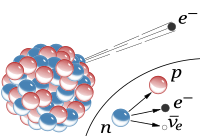
Photo from wikipedia
Abstract We explore the prospects for bounding the weak scale using the weak gravity conjecture (WGC), addressing the hierarchy problem by violating the expectations of effective field theory. Building on… Click to show full abstract
Abstract We explore the prospects for bounding the weak scale using the weak gravity conjecture (WGC), addressing the hierarchy problem by violating the expectations of effective field theory. Building on earlier work by Cheung and Remmen, we construct models in which a super-extremal particle satisfying the electric WGC for a new Abelian gauge group obtains some of its mass from the Higgs, setting an upper bound on the weak scale as other UV-insensitive parameters are held fixed. Avoiding undue sensitivity of the weak scale to the parameters entering the bound implies that the super-extremal particle must lie at or below the weak scale. While the magnetic version of the conjecture implies additional physics entering around the same scale, we demonstrate that this need not correspond to a cutoff for the Higgs potential or otherwise trivialize the bound. We stress that linking the WGC to the weak scale necessarily involves new light particles coupled to the Higgs, implying a variety of experimentally accessible signatures including invisible Higgs decays and radiative corrections in the electroweak sector. These models also give rise to natural dark matter candidates, providing additional paths to discovery. In particular, collective effects in the dark matter plasma may provide a telltale sign of the Abelian gauge group responsible for bounding the weak scale.
Journal Title: Journal of High Energy Physics
Year Published: 2019
Link to full text (if available)
Share on Social Media: Sign Up to like & get
recommendations!